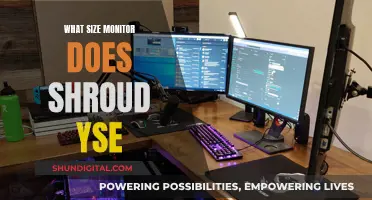
Ankle monitors are often used as an alternative to prison sentences, allowing offenders to remain in their homes or travel to specific locations, such as work, while serving their sentences. These devices are typically used for first-time and non-violent offenders, including those with substance abuse issues, and can be used to enforce sobriety. Offenders are usually required to pay for the cost of the device and its daily use, which can amount to hundreds of dollars per month. In the case of non-compliance, law enforcement agencies are alerted, and the offender may face serious consequences, including arrest and jail time.
| Characteristics | Values |
|---|---|
| Who wears ankle monitors? | Offenders awaiting trial, those on house arrest, probation, or parole, and people with substance abuse issues |
| Why are they worn? | To ensure the wearer doesn't get into more trouble, as an alternative to jail time, and to reduce bail costs |
| Types of ankle monitors | Radio frequency, GPS, Secure Continuous Remote Alcohol Monitor (SCRAM) |
| What do they track? | Location, alcohol consumption, drug use |
| Who pays for them? | The wearer, private companies, or the state |
| Cost | Setup: $175-$200; Daily fee: $5-$40; Monthly fee: up to hundreds of dollars |
What You'll Learn
- Ankle monitors are used for house arrest, alcohol monitoring, or bail pending trial
- They are cheaper than prison, costing $6,000 per year compared to over $20,000
- Offenders usually pay for the monitor and a daily use fee
- They are also used for those on probation or parole
- Monitors can detect alcohol in sweat

Ankle monitors are used for house arrest, alcohol monitoring, or bail pending trial
Ankle monitors are often used as a way to enforce house arrest, monitor alcohol consumption, or ensure that individuals show up for their bail pending trial.
House Arrest
Ankle monitors are commonly used to enforce house arrest, particularly for individuals who are considered a danger to the community or a flight risk. This means that the individual must stay within the boundaries set by the court and may only leave their home under certain pre-approved conditions. Violating the terms of house arrest can result in additional penalties, including jail time.
Alcohol Monitoring
Ankle monitors can also be used to monitor alcohol consumption, especially for individuals with drunk driving convictions or those who are ordered by the court to refrain from drinking. The SCRAM CAM bracelet, for example, samples the wearer's perspiration every 30 minutes to test for alcohol. This helps to ensure compliance with court orders and increases community safety.
Bail Pending Trial
In some cases, ankle monitors are used as an alternative to bail for individuals awaiting trial. This allows them to remain free while ensuring they meet certain conditions set by the court. If an individual is deemed a flight risk, the court may order them to wear an ankle monitor to track their movements and location. This provides an added layer of assurance that the individual will appear for their court date.
The use of ankle monitors can vary depending on the jurisdiction, the severity of the crime, and the individual's criminal history. Overall, they serve as a way to monitor and restrict the movements of individuals who are either awaiting trial or have been convicted of certain offences.
Blind Spot Monitoring: Both Sides, Now
You may want to see also

They are cheaper than prison, costing $6,000 per year compared to over $20,000
Ankle monitors are often used as an alternative to prison sentences, particularly for low-risk, non-violent offenders. They are also used for those awaiting trial, as a condition of bail or parole.
The cost of incarceration is a significant factor in the decision to use ankle monitors. The cost of keeping a person in prison for a year is over $20,000, whereas the cost of an ankle monitor and house arrest is around $6,000 per year. This price difference has led to the increased use of ankle monitors as a more financially viable option for the criminal justice system.
In some cases, the cost of the ankle monitor is passed on to the offender, who is forced to pay for it as part of their sentence. This can be a significant financial burden, with private companies charging hundreds of dollars a month for the device and surveillance. The daily fee for the monitoring device can range from $5 to $40, and there is often an additional set-up fee of up to $200. These costs can quickly add up, especially for those who have to wear the device for years or even a lifetime.
While ankle monitors are generally cheaper than prison sentences, the cost can be significant, especially for those who cannot afford it. This has led to criticism that ankle monitors place poor people in special jeopardy, as they may be unable to pay for the device and end up back in jail.
Despite the cost, ankle monitors are still seen as a more humane and effective alternative to incarceration, especially for those with substance abuse issues. They allow offenders to avoid the negative influences of prison while also providing a level of supervision and accountability.
Halter Monitor: What Does It Tell About Your Heart?
You may want to see also

Offenders usually pay for the monitor and a daily use fee
Offenders who are required to wear ankle monitors are usually those who have committed serious crimes, such as murder, sexual assault, or major drug offences. They are also used for repeat offenders, those convicted of multiple DUIs or DWIs, and in cases of domestic violence. Ankle monitors are often used as an alternative to jail time, with judges offering them to low-risk or non-violent offenders as a way to reduce prison overcrowding.
Ankle monitors are typically used to track an individual's movements and location, with most using radio frequency or GPS to do so. They are usually about the size of a pager and are strapped to the ankle with a tamper-proof band. In addition to tracking location, these monitors can also be used to detect alcohol consumption through the skin, ensuring compliance with court orders to refrain from drinking.
The costs associated with ankle monitors can be significant, with offenders usually responsible for paying for the device and daily use fees. The set-up fee for an ankle monitor typically ranges from $175 to $200, while the daily fee can be anywhere from $5 to $40. These fees can add up quickly, especially for offenders who are required to wear the device for extended periods or even lifetimes. In some cases, failure to pay the fees can result in extended supervision, additional fees, or even jail time.
The fees for ankle monitors vary depending on the company providing the device and the state in which the offender is located. While some states, like California, have passed legislation expressly prohibiting the use of electronic monitoring fees, most states allow them, and a few even require them. The fees can be daily, weekly, monthly, or flat fees, and are imposed on top of any other costs associated with the criminal legal system.
Overall, the use of ankle monitors as an alternative to incarceration comes with a financial burden for offenders, who are often already facing economic challenges. While ankle monitors can provide a valuable alternative to jail time, the associated fees should be considered and addressed by the criminal justice system to ensure fairness and accessibility.
Blind Spot Monitoring: Lowering Insurance with Safety Tech
You may want to see also

They are also used for those on probation or parole
Ankle monitors are often used as an alternative to prison sentences, allowing offenders to serve their sentences at home or in the community. They are also used for those on probation or parole, with the aim of reducing the risk of reoffending and helping them reintegrate into society.
For those on probation or parole, ankle monitors provide a way to ensure that individuals are complying with the conditions of their release. This may include restrictions on their movements, such as curfews or limits on where they can go. For example, a person on probation may be required to stay within a certain radius of their home or avoid certain places or people. Ankle monitors can also be used to enforce sobriety, with Secure Continuous Remote Alcohol Monitor (SCRAM) devices testing the wearer's sweat for alcohol consumption. This is particularly relevant for those on probation or parole for alcohol-related offences, such as Driving Under the Influence (DUI).
In addition to monitoring location and sobriety, ankle monitors can also be used to enforce regular check-ins with probation or parole officers. This allows for more frequent supervision and support, which can help reduce the risk of reoffending. Ankle monitors can also provide peace of mind for victims and the wider community, especially in cases where the offender is considered a potential danger or flight risk.
While ankle monitors offer an alternative to incarceration, they do come with costs. Wearers are often required to pay for the device and daily use fees, which can be a financial burden, especially for those from low-income backgrounds. There may also be installation fees and costs for monitoring services, which can add up to hundreds of dollars per month. In some cases, private companies charge these fees, and failure to pay can result in further legal consequences, including possible incarceration.
Overall, ankle monitors are seen as a way to reduce prison populations and provide a more humane alternative for low-risk offenders. By allowing individuals to serve their sentences in the community, ankle monitors can help with reintegration and potentially reduce the risk of reoffending. However, the costs associated with ankle monitors and the potential for further legal consequences if conditions are not met are important considerations.
Internet Privacy: Government Surveillance and Online Monitoring
You may want to see also

Monitors can detect alcohol in sweat
Ankle monitors are sometimes used to allow people to remain free while awaiting trial, provided they meet certain conditions set by the court. They are usually reserved for people awaiting trial who are considered a danger to the community or a flight risk.
Ankle monitors can be used as an alternative to a jail sentence, typically for low-risk offenders. If you have to wear an ankle monitor, you’ll need to adhere to specific rules and regulations. For instance, you may have to refrain from drinking alcohol.
The Secure Continuous Remote Alcohol Monitor (SCRAM) bracelet can detect alcohol in a person’s sweat, thus alerting the authorities if the person violates the terms of their release by drinking. SCRAM devices test the wearer's sweat for alcohol approximately every 30 minutes and then wirelessly transmit the results to a regional monitoring centre. If a certain amount of alcohol is detected, the court or the probation officer is notified.
SCRAM bracelets can detect small amounts of alcohol in your sweat, even blood alcohol concentrations below 0.02%. However, most jurisdictions only consider it a violation if the device detects a BAC of 0.02% or higher.
Monitor Bandwidth and Data Usage Like a Geek
You may want to see also
Frequently asked questions
Ankle monitors are typically worn by individuals on probation or parole, or those awaiting trial. They are also used for people who have been convicted of a crime but are considered low-risk and not a danger to the community.
Ankle monitors are often used as an alternative to traditional imprisonment, allowing individuals to serve their sentences while remaining in the community. They are also used as a way to reduce bail amounts.
The rules for wearing an ankle monitor can vary depending on the individual's situation. Some common rules include sticking to a specific area, avoiding certain people, adhering to a curfew, and abstaining from drugs and alcohol.







